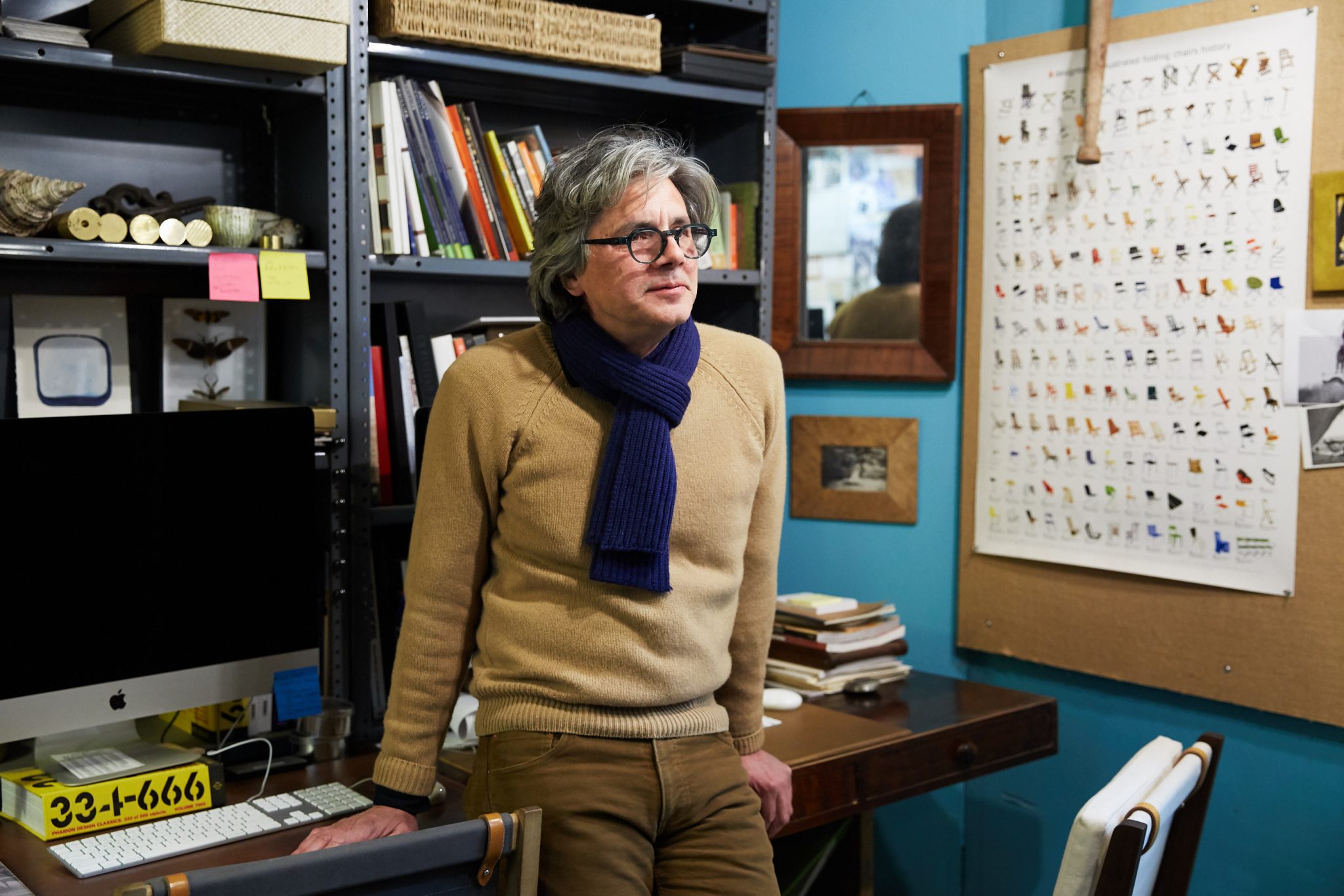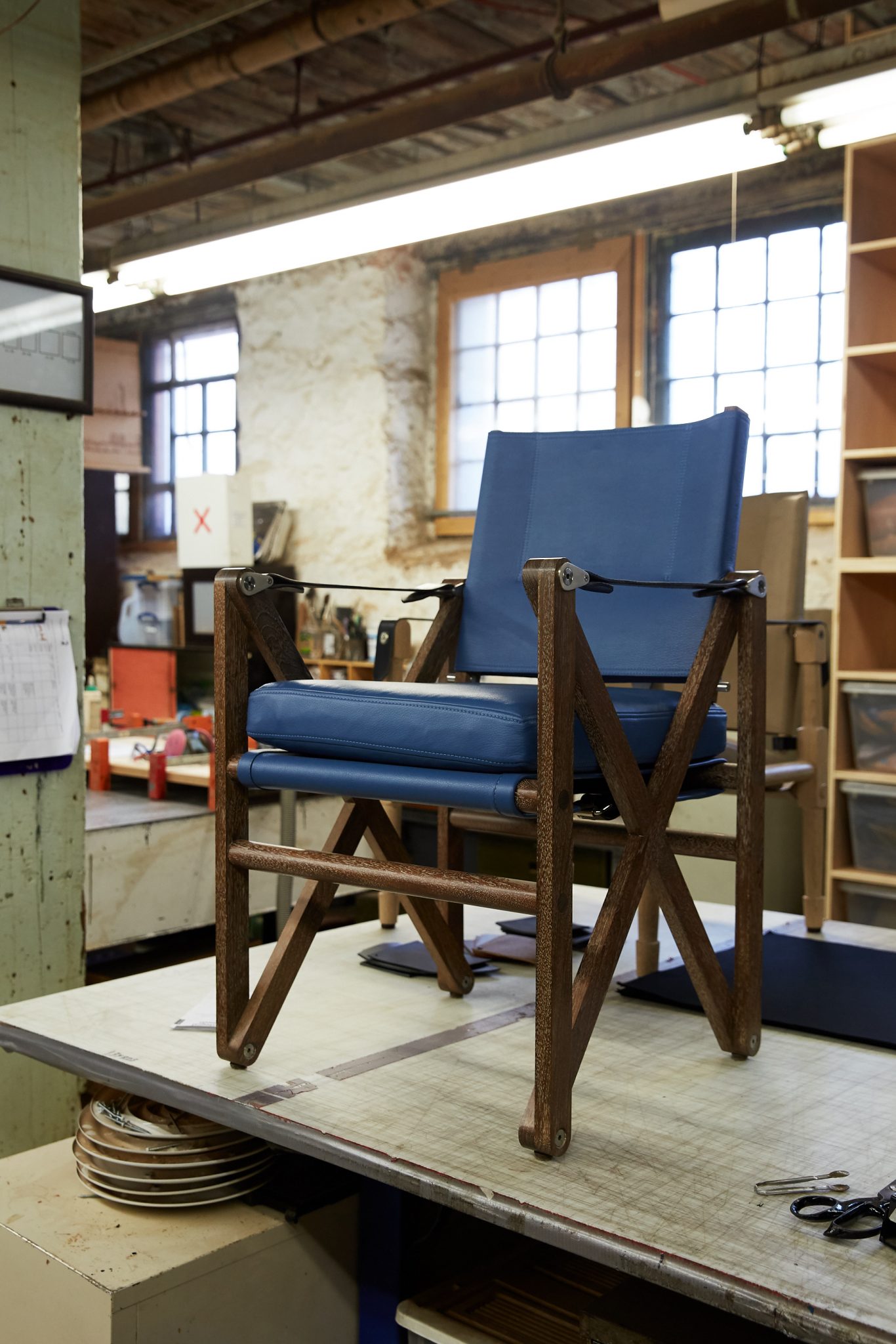I think everyone that comes to work with me shares the same passion, and that is being actively engaged in the craft of making things.
— Richard Wrightman
We’ve long admired Richard Wrightman’s campaign-inspired furnishings, which pull off the neat trick of referencing specific moments in history while feeling entirely timeless, and even modern. Wrightman’s father was an army officer who collected campaign furniture, including an array of British Officer’s Chairs that the young designer — a self-described “army brat” —- pulled apart and reassembled with soldier-like precision every time the family relocated. Years later, his updated, upscale versions of these military classics are coveted for the way they revive the romance of a bygone era with a luxurious take on utility and versatility. We visited Wrightman’s Long Island City studio for a closer look at the process and materials that have made the products of this 17-year-old company as coveted as, if not more so than, their original inspirations.
Captions below by Wrightman.

 Full Screen
Full Screen Nicholas Brawer British Campaign Furniture – Elegance Under Canvas which was a guiding light in my early days.

 Full Screen
Full Screen What’s known as the British Officer’s Chair was developed in Roorkee India by the India Army Corps of Engineers for the British. The ubiquitous charpoy bed was the likely inspiration.
I wanted to reference campaign furniture but produce a more contemporary version, almost as if the days of campaigning were still here. Nobody travels this way anymore, so there isn’t a need for field furniture of this calibre, but what’s still alive is the romance for that age.
Ronen Lev: We’d love it if you could start by giving us a brief history of campaign furniture, in your own words.
Richard Wrightman: Campaign furniture denotes any products that are designed to be broken down or folded for ease of travel. From Egypt to Rome, every empire on the march had some form of furniture made for travel. But generally speaking, when one thinks of campaign furniture, the association is British. The term was popularized in the 19th and 20th centuries by British military campaigns, where certain standards of sophisticated living needed to be upheld in the field. At the height of colonial expansion, Britain had the most far-reaching empire in history. From Africa to Asia and to the East and West Indies, gentleman officers would go to great expense to maintain their prestige and station in life by ensuring their encampments had every comfort and luxury of home. Between camps the columns of porters carrying these goods would often extend for miles.
Campaign furniture engaged the skills of the finest designers and makers from the Georgian to Victorian eras. Especially prized were pieces that transformed from one into another, such as a round table that sat four but could also extend to seat twenty, or a sofa that would convert into a canopy bed. For their time, these pieces were state of the art, and many designs were patented for their ingenuity.
By the turn of the 20th century, the days of military campaigns followed by caravan came to an end. Furnishings became lighter and more utilitarian because the British had to adapt to a new kind of war, which required a lighter and more mobile army.
Ronen Lev: Your father, an army officer, collected campaign furniture. What are some of your earliest memories of interacting with those pieces?
Richard Wrightman: The Chatwin Chair that I produce today is not unlike the British Officer’s Chairs I grew up with, and I can remember taking them apart and reassembling them countless times as we moved to and from Europe. Military history played a larger part in my imagination than most boys my age, and I naturally gravitated towards anything that bore a military style. I had a particular fascination with my father’s campaign furniture because there was a sense of history and far-off places reminiscent of long voyages and expeditions.
Ronen Lev: Campaign furniture was historically designed to be ‘folded up’ and carried long distances. Are all the items in your collection collapsible?
Richard Wrightman: With my collection I wanted to reference campaign furniture but produce a more contemporary version, almost as if the days of campaigning were still here. Nobody travels this way anymore, so there isn’t a need for field furniture of this calibre, but what’s still alive is the romance for that age. There are many designs in my collection that break down or fold in the traditional manner, but it’s not a prerequisite and not everything I do is in a campaign style. However, everything I do relates to my particular way of seeing things.

 Full Screen
Full Screen We offer 25 different woods and finishes from light to dark woods, from white oak, to walnut, teak and wenge.

 Full Screen
Full Screen Wood samples are constantly in production and I am always experimenting with different methods. Here I’m looking at the results of a new recipe where I’ve used a traditional ebonizing method of dissolved steel wool in vinegar on white oak.

 Full Screen
Full Screen The Chatwin Lounge was the first Roorhee chair type that I made in 2002 and followed over the years by dining and bar chairs and a bench.
The best advice came from a friend who said how important it is to trust your instincts — in all aspects of life but especially business, because so much depends on making the right decision.
Ronen Lev: What year did you officially launch your company, and how did you decide on LIC as your home base?
Richard Wrightman: I established my studio in 2000 and it took me a year of experimentation until I found the style I wanted to pursue. But I would say I officially launched my fledgling collection at ICFF in 2001 with just 4 pieces. I chose LIC because my dear friend Eleanor had some space she wasn’t using in her 40,000 square foot building, and I’ve been here ever since.
Ronen Lev: How do you define yourself as a maker, and how has that definition changed over time?
Richard Wrightman: I got my start in fabrication in 1996 working in the Brooklyn Navy Yard for an architectural metal fabrication company called Product and Design. What began as an exploration ended up as a life-changing experience. I didn’t realize then that I was a part of a whole new demographic that wanted to do something authentic. Once on my own, I was active making things until 2010 when I realized I had to step back and focus more on running the company. I still I spend a good portion of my day in the studio overseeing production and working with my crew, but I feel less a maker now and more of an art director. One of the best things I’ve done is to cross-train my crew. All of them are experts not only as furniture-makers but in metal-and leather-working, finishing, sewing, CAD and photography. Having a crew that you can absolutely trust is so essential, and at times I feel like if I wanted to I could take a six-month hiatus. It’s not likely to happen soon because I love what I do, and every Monday I’m so happy I get to come back to the studio.
Ronen Lev: Why have you chosen to keep production as handmade as possible?
Richard Wrightman: I think everyone that comes to work with me shares the same passion, and that is being actively engaged in the craft of making things. We certainly use machines, and the closest thing we have to automation is our copy lathe, but even that requires a great amount of skill. I don’t think automation is necessarily faster than by hand. The one advantage is that every part is the same. With automation and CNC (computer numerical control), the question becomes what does the operator do other than feed parts to a machine and press a button?
Ronen Lev: How has your design process changed over the years?
Richard Wrightman: I can’t say it’s changed because the way I search for ideas is essentially the same as when I started. I’ve always thought the title of Paul Smith’s book, You Can Find Inspiration Everywhere, says it all. A designer is hardwired to look for inspiration everywhere. I find inspiration in cinema, in print, museums, shop windows, architecture and automotive design. I believe Diana Vreeland said, “The eye has to travel.” Growing up, I shifted between the United States and Europe every two years, and I was struck very early on by the contrasts between cultures, how each country looked so different from the next. I’m inspired by seeing things from the corner of my eye, looking at things obliquely to catch something new. When I start a new project it usually starts with quick sketches to capture an idea. Development begins three-dimensionally on the computer, and from there the prototype.
Ronen Lev: What advice can you can give designers starting their own furniture company?
Richard Wrightman: Create designs that are unique to you and the marketplace. Keep it simple, keep your overhead low, stay on top of your books and remember you’re in a service industry. It’s important to deliver on time and keep your clients happy.
Ronen Lev: What’s the best advice you’ve ever gotten?
Richard Wrightman: The best advice came from a friend who said how important it is to trust your instincts — in all aspects of life but especially business, because so much depends on making the right decision. Inevitably there’s bad advice, too. In my early years I was advised to outsource the production of my furniture, which I explored but ultimately resisted because it was contrary to my interests.
I still love seeing a piece of furniture come together and making the hundreds of decisions each day that affect the look and feel of each piece that we make. My point here is how important it is to align business decisions with what is fundamental about one’s passions and stay true to them.
Ronen Lev: Whats next for Richard Wrightman?
Richard Wrightman: For years I’ve been wanting to design a line of upholstery, so that’s my goal for this year.

 Full Screen
Full Screen The leg of a folding Matthiessen luggage rack being tested for fit as it comes off the lathe. So much goes into turning a leg that if a tenon is too small it becomes scrap.

 Full Screen
Full Screen Lathe templates, one for each leg type in the collection, from Chatwin Chairs, Jasper Bench to Matthiessen Stool

 Full Screen
Full Screen We use leathers of different thicknesses for different purposes. Here’s Sedgwick English bridle leather that we use for strapping. We use it because it’s thick and strong.












































